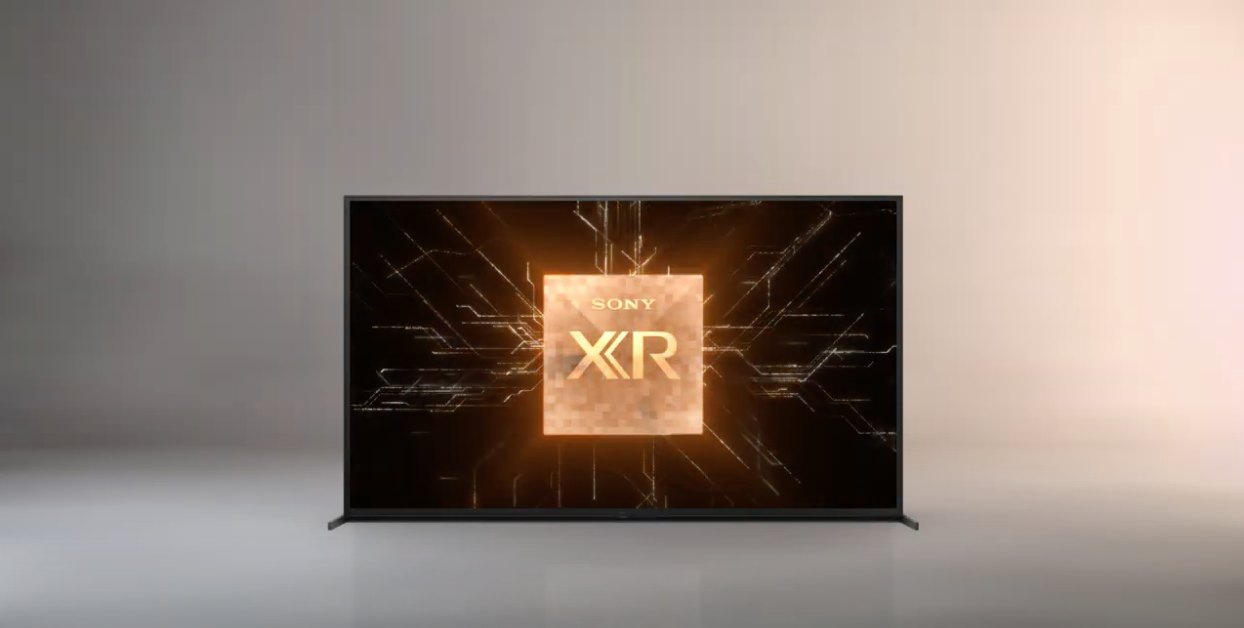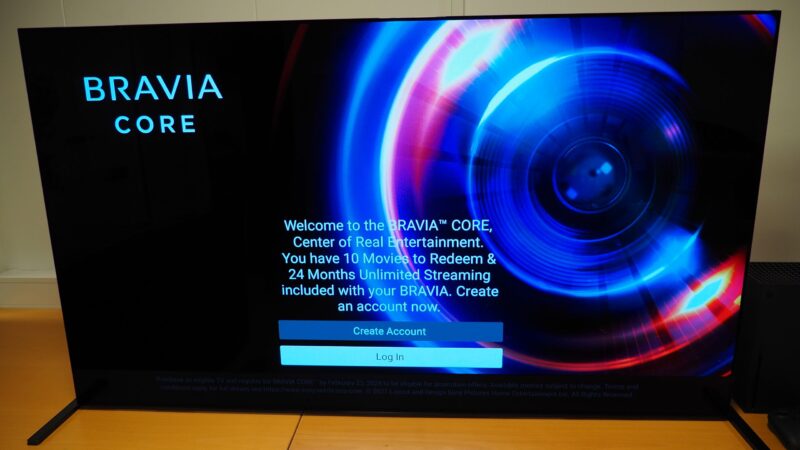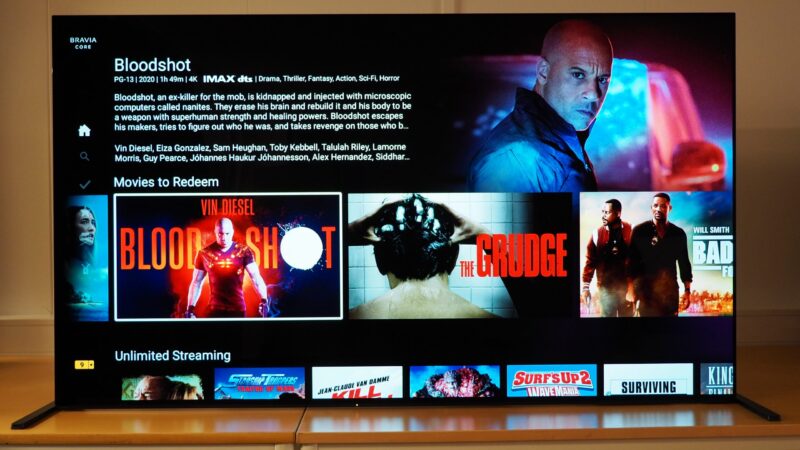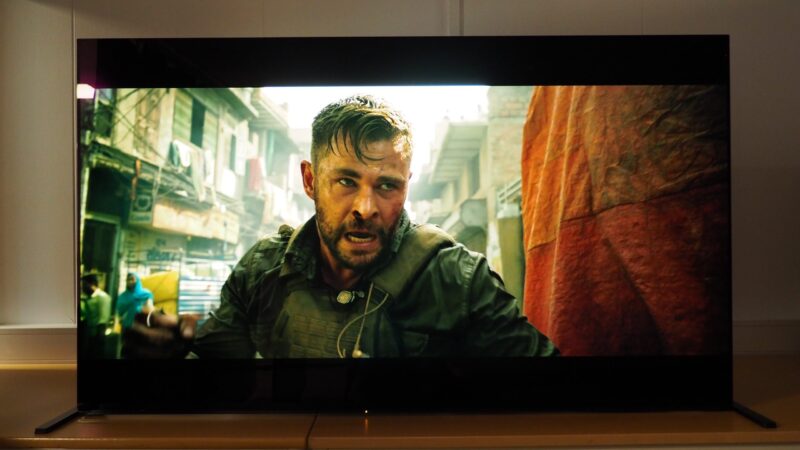Sony is far from being the world’s largest TV producer, but they often stand out among the very best when it comes to picture and sound. The Japanese manufacturer was responsible for some of the TVs we remember best from 2020, including the 8K model ZH8 and the affordable A85. On the other hand, they were missing in action in the absolute high-end class of OLED screens.
The so-called “Master series” KD-65AG9, which we tested the year before, never got a direct successor in 2020. Sony’s then top model received much praise for the image quality, but at the same time had to endure criticism for rather poor brightness.
Sony has taken its time, but now the top model for 2021 is finally ready. And this time, the preparations have been successful: The newcomer A90J comes loaded with an extra bright OLED panel, powered by a super-smart video processor (Bravia XR). It also has better connectivity, as well as the all-new Google TV platform. Those who buy Sony’s top model can also look forward to the Bravia Core, which is their own exclusive power service. In other words, there is a lot to look forward to here!
The Sony Bravia XR A90J comes in 55″, 65″ and 83″ screen sizes. In this review, we have tested the 65-inch XR-65A90J, but most will be the same for the entire series.
Design
Sony’s OLED screens have had a distinctive, minimalist design since the first generation – luxurious without being flashy. The A90J fits into the range, with a sleek black metal frame.
This year’s model has a new plinth solution: Instead of a center-mounted foot, the A90J has two small feet that are mounted at the edges. With these, the TV rests only a few millimeters above the table surface, and is very stable. In return, they require a similarly wide TV cabinet: Sony has not made room for central mounting of the feet on the 55 “and 65” model – however, this should be possible on the 83-inch.
If you plan to place a soundbar in front of the TV, you also have the option of mounting your feet in an alternative way that raises the screen slightly. Otherwise, it is of course possible to wall mount the TV (300 x 300 mm VESA dimensions).
Usability and features
The Bravia XR-65A90J is actually the first 2021 model we have on the test bench. It is also the first TV with the latest Android user interface from Google – also known as Google TV.
The new Google platform features a new launch menu, which provides a complete overview of your most used apps, as well as TV channels and connected devices. It also provides direct recommendations for content, based on preferences and what you have previously watched. The user experience is very similar to today’s YouTube app, but extended to all types of TV content. The Sony screen also has a built-in Google Assistant, where you can talk directly to the TV without having to use the remote control.
New remote control
The A90J also comes with Sony’s new premium remote control. It has a beautiful design in brushed metal. The buttons are backlit, and this year’s model has been updated with shortcut buttons for YouTube, Netflix, Disney+ and Amazon Prime Video.
Otherwise, we notice that the TV responds quickly to commands, and Sony has done a good job of implementing its own features and settings on top of the new Google interface.
Bravia Core
Another novelty on this year’s top models is Bravia Core – Sony’s own streaming service. It is reserved for the latest 2021 models with Bravia XR processor, and offers fresh feature films from Sony Pictures Entertainment.
Those who buy a Bravia A90J get a 2-year power subscription plus 10 so-called “Movie credits” with the purchase. The streaming service offers several classic Sony titles, while you have to trigger a credit to watch recent movies.
We took a quick look at the new service, which at first felt a bit unfinished. The menu structure feels a bit unfamiliar and illogical to navigate. We struggled a bit to get an overview of the available content, and experienced at times that the service loaded slowly or lost contact with the server. This is probably because we tested the Sony screen before it was officially available in stores.
The picture quality, on the other hand, is impeccable: Several of the films are available in 4K HDR format, and Bravia Core excels in being able to stream at a very high bit rate (up to 80 megabits per second). We did not quite reach this speed in our case (however 50-60 mbps), but a look at, among others, Vin Diesels Bloodshot revealed an impressively sharp image reproduction, which was noticeably free of compression noise. Let’s have more of this, thank you!
Unfortunately, Bravia Core currently seems to be a fairly narrow investment: the service is reserved for those who buy the latest TV models, and does not apply to Sony’s 2020 models, for example. You also do not have the opportunity to extend the subscription beyond what you get when you buy the TV. A little strange, but we assume that it (as usual) has to do with film rights.
Stay tuned to LB tech reviews for a more in-depth test of Bravia Core at a later date, when the service is completely ready.
Top-tuned panel and processor
Sony is already known for its good image processing, and for the 2021 vintage they have developed a completely new video processor. The new XR processor is based on so-called cognitive intelligence – advanced knowledge of how people see and focus their eyes on various objects. The processor divides the screen into several zones, finds the assumed focus point in the image – such as a face – and optimizes colors, contrast and sharpness exactly where it is needed.

The A90J has also got a brand new OLED panel. Whether it is a so-called Evo panel from LG Display or another top-trimmed variant, we have not yet confirmed. In any case, Sony claims that they have achieved higher brightness through smarter image processing, and not least better cooling: there is a thin cooling element of aluminum behind the image panel, which helps to dissipate the heat. In this way, the panel must withstand much higher brightness without the risk of permanent burn-in.
Image quality
But proof of the pudding is in the eating: what the TV looks like in practice! When we tested the predecessor KD-65AG9 in 2019, we were nearly all satisfied – with one important exception: The brightness from the OLED panel was quite low. Sony had chosen a rather conservative, careful image aesthetic compared to the competition, which made demanding HDR scenes simply look a bit tame and lifeless.
Sony seems to have noticed the criticism, because precisely the brightness is something they have managed to improve on the A90J. And not just a little! We already notice when the Sony logo lights up for us for the first time, that this TV is of a different caliber.
While previous OLED models have appeared a bit dim and pale in sunny rooms, the Sony A90J has more than plenty of power. It lights up the room in a way that is immediately reminiscent of a bright LCD TV! White turns really white, and even broadcasts from the Biathlon World Cup with lots of snow all over the screen, look convincing and contrast strong in a bright room. This will clearly help to raise the area of use, from pure “cinema TV” to a TV that handles all kinds of user scenarios.
Another positive side effect of the generous brightness is that the HDR effects get significantly more intensity. Highlight effects such as sunlight, flames and the like look almost glowing!
Great contrast
The action movie Extraction (Netflix) has some demanding scenes that we like to come back to: The picture quality is great, and is provided in Dolby Vision HDR format. The party where mercenary Tyler is chased through Dhaka city, starts in daylight, takes through shady alleys, and on to pitch-dark underground tunnels. The session is characterized by fast panning and fast scene changes from dark to light, which puts both the screen and the video processing to a very tough test.
Nothing to complain about on the A90J here: In fact, the Sony screen masters the demanding scenes better than any other TV we’ve seen so far! It can be dazzlingly strong in one lot, dark in the next, without drowning the details in noise or excessive black (black crush). Without a taillight (it is after all an OLED we are talking about) there are also no problems with halo effects. It simply looks great when an OLED gets proper brightness!
We were naturally excited about what kind of impact the new “super-intelligent” XR processor would have on the image experience: Has Sony fallen into the trap and put on too much artificial party and fireworks, or does it still look natural? Fortunately, the answer is the last.
Despite a lot of advanced image processing, the Sony processor seems to work in a very discreet way. While many of the competitors tend to exaggerate contrast, color and sharpness, Sony has landed on an image that looks frighteningly realistic, while maintaining a neutral color balance.
The movements are also excellent: In season 1, episode 7 of Cobra Kai, there are some small ripple effects in the water that can break up on some TVs. The Sony screen masterfully captures the tiny movements of this scene.
In these streaming days, it is also gratifying to see that Sony has achieved a very effective noise reduction. Even though the power services have become so good, they are often characterized by a variable bit rate which can lead to block-like noise and distortion. The Sony screen is very good at reducing this noise, without messing with the small details.
All in all, we found very little to complain about in the image reproduction. The A90J gives us the feeling of sitting with an embarrassingly accurate studio monitor, where you can really frolic in all types of video content.
Competitors?
This is the first 2021 model we have on the test bench, and the list of potential challengers is long. A model that is highly anticipated is LG’s new G1 with newly developed “Evo” panel, which promises a significant increase in brightness. Sony, for its part, has achieved an improvement through better cooling and image processing. Another OLED challenger is the Panasonic JZ2000, which takes over for the super cool GZ2000 from last year. But the big “talking point” this year is of course the new QLED Neo models from Samsung, which promise significantly better light control and contrast than previous generations. How the A90J will do against all these high-end challengers remains to be seen, but so far Sony has put the list high!
Sound quality
The A90J uses Sony’s well-known Acoustic Surface Audio speaker system, where the sound is transmitted straight out of the screen using small, invisible speaker units anchored in the image panel itself. This year’s model has a slightly upgraded system, with stronger sound pressure and a wider frequency range than its predecessors.
We have good experience with this sound solution from previous models, and the A90J sounds impressively good as well. The fact that the sound comes from exactly the same place as the image, gives a captivatingly realistic effect, which helps to draw us close to the action.
The Sony screen still has, despite recent improvements, some limitations compared to traditional soundbars. We notice that the sound sounds a little more compressed and strained when we turn up the volume. And even though the sound itself is rich enough, we miss a little pressure at the deepest end of the bass.
Here, the Sony screen must find itself beaten by the Philips OLED935, which has an even larger and clearer sound image. The latter can also be expanded with an extra subwoofer, if you crave for deeper bass.
The Sony screen also has no built-in Atmos height channels, like we can find on Panasonic’s top model HZ2000 and the upcoming JZ2000, for example. If you want full-blooded three-dimensional Atmos sound, you have to resort to an external soundbar. Sony has made this easy via the HDMI eARC audio output. Besides, it’s nice that the built-in speakers are kept out of sight.

Conclusion
Has Sony managed to improve its new flagship TV for 2021? Indeed they have! The Bravia XR A90J combines a powerful upgraded image panel with a highly efficient video processor, which results in very good picture quality. All the usual OLED benefits are there, with sparkling colors and bottomless black level. At the same time, the brightness is significantly improved from previous models.
With up to 1300 nits in the brightest parts, the A90J is capable of delivering dazzlingly realistic HDR video reproduction in both dark and light environments. The built-in, invisible speaker solution works great. With HDMI 2.1 compatible inputs (though only two of them), the Sony screen is also ready for gaming. Add a well-functioning smart TV solution and smart remote control, and you have a close-up optimal all-round TV screen for all types of TV entertainment.
Calibration of Sony Bravia XR A90J
The Sony Bravia XR A90J supports automatic calibration via the Calman Autocal PC application. The use of calibration software is primarily aimed at professional or advanced users who want as accurate a picture as possible. In addition, it is useful to check that the TV keeps what it promises!
In Sony’s case, the process went smoothly: By downloading the Calman app for Bravia, we automatically got connection between PC and TV via Wi-Fi.
Right out of the box, our test specimen gave a relatively neutral color balance, with just a hint of too much blue, a little too little green, and a faint pull toward magenta and blue.
The measurements in Custom mode (SDR) had a total delta deviation of 2.4 grayscale, 2 in the color space, which is approved, and well within the tolerance of consumer screens on delta 3.0.
After a quick calibration, we got grayscale deviation of 0.4 and color space deviation of 0.6. Which is close to perfect! The measurements in HDR mode were also very precise: even after only calibrating SDR, we got 0.8 delta deviations in the visible dynamic range of less than 1 in grayscale and 1.6 in the color space. It’s roughly in line with a professional studio monitor!
With the way the Bravia TVs are set up, you only need to do a simple SDR calibration (2.2 gamma), then the TV automatically calculates other modes such as HDR etc, based on the measurement you have made. This eliminates the need for extensive HDR calibration. Smart and time-saving!
We also experienced in practice that the calibration went quickly and smoothly, without us having to do a lot of manual tricks or troubleshooting to get to the finish line. Which suggests that Sony and Calman have done their homework.
The brightness is also impressive: In fully calibrated custom mode (HDR), we measured the Bravia A90J to a full 1300 nits on 10% screen area. That is significantly more than the Panasonic HZ2000, which has previously clocked in about 900 nits on similar measurements. Thus, Sony sets a new track record!
| Skjermareal | Lysstyrke (nits) | Kommentar |
| 1 % | 1450 | Dropper til ca 900 etter 5 sekunder |
| 5 % | 1450 | Dropper til ca 900 etter 5 sekunder |
| 10 % | 1300 | Dropper til ca 900 etter 5 sekunder |
| 50 % | 330 | |
| 100 % | 200 |
Another thing we noticed during the measurements is that the Sony screen does not seem to be bothered by burn-in. The bright test windows often leave a temporary shadow on the screen surface, but here they disappeared quite immediately without annoying nuisance – which can probably be attributed to more efficient cooling.
All calibration performed by Gorm Sørensen @ ProCal.

We think
Sony's new top model serves beautiful and contrast-rich image quality with immensely strong brightness, plus excellent sound from the hidden speakers. Only two of the four HDMI inputs are HDMI 2.1 compatible. Oh, the expense!
2699 €
Specifications
- Size/type: 65″4K OLED
- Resolution: 3840 x 2160 (4K Ultra HD)
- Operating System: Google TV (Android 10)
- Inputs: 4 HDMI (2 x 2.1), 3 USB
- Outputs: Optical digital audio output
- HDR: HDR10, HLG, Dolby Vision
- Other: Acoustic Surface speakers
- Web: sony.co.uk






















